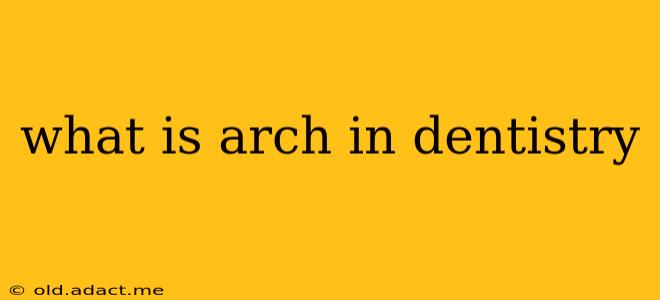In dentistry, an arch refers to the curved arrangement of teeth in either the upper or lower jaw. These two arches, the maxillary arch (upper) and the mandibular arch (lower), work together to allow for proper chewing, speaking, and facial aesthetics. Understanding the dental arch is crucial for diagnosing and treating various dental problems.
What are the components of a dental arch?
Each dental arch is composed of several key elements:
- Teeth: The individual teeth are the primary components, arranged in a specific order and shape to create the curved arch. The arrangement and number of teeth vary depending on age and individual development.
- Alveolar Bone: This is the bone that surrounds and supports the roots of the teeth. It forms the sockets into which the teeth are embedded. The shape and density of the alveolar bone directly influence the shape of the dental arch.
- Gingiva (Gums): The gums surround and protect the teeth and alveolar bone. Their health is critical to maintaining the integrity of the entire arch.
- Periodontal Ligament: This connective tissue acts as a cushion between the teeth and the alveolar bone, allowing for slight movement and shock absorption during chewing.
- Palate (Maxillary Arch Only): The palate forms the roof of the mouth and is a crucial element in the maxillary arch's structure and function.
How is the dental arch developed?
The development of the dental arches is a complex process that begins in utero and continues through childhood and adolescence. Genetic factors, as well as environmental factors such as thumb-sucking or bottle-feeding habits, can influence the final shape and alignment of the arches. Proper development is essential for optimal oral health and function.
What are some common problems related to the dental arch?
Several issues can affect the shape, alignment, and overall health of the dental arches:
- Malocclusion: This refers to any deviation from the ideal alignment of the teeth in the arches. Various types of malocclusion exist, ranging from minor crowding to severe overbites or underbites.
- Crowding: This is a common problem where teeth are too tightly packed within the arch, potentially leading to misalignment and increased risk of gum disease.
- Spacing: In contrast to crowding, spacing refers to gaps between teeth within the arch.
- Crossbite: This occurs when some upper teeth bite inside the lower teeth, instead of the normal overbite.
- Overjet: This describes a significant horizontal protrusion of the upper teeth beyond the lower teeth.
- Open bite: This refers to a gap between the upper and lower incisors when the teeth are closed.
- Arch asymmetry: This involves differences in the size and shape of the left and right halves of the dental arches.
How are dental arch problems diagnosed and treated?
Diagnosing dental arch problems typically involves a comprehensive oral examination, including visual inspection, X-rays, and potentially models of the teeth (dental casts). Treatment options vary greatly depending on the specific problem and its severity and might include:
- Orthodontic treatment (braces): This is commonly used to correct malocclusion and improve the alignment of teeth within the arches.
- Interceptive orthodontics: Early intervention to address developing arch problems in children.
- Removable appliances: These can be used for minor adjustments and corrections.
- Surgery: In some severe cases, surgical intervention may be necessary to correct skeletal discrepancies affecting the arches.
What is the importance of maintaining a healthy dental arch?
Maintaining a healthy dental arch is critical for several reasons:
- Chewing and biting efficiency: A properly aligned arch allows for optimal chewing and biting, contributing to overall digestive health.
- Speech clarity: The alignment and shape of the dental arches significantly impact speech production.
- Facial aesthetics: The arrangement of the teeth plays a crucial role in facial appearance and overall aesthetic harmony.
- Oral health: A well-aligned arch is easier to clean, reducing the risk of cavities and gum disease.
By understanding the dental arch and its potential problems, individuals can take proactive steps to maintain optimal oral health and a beautiful smile. Regular dental checkups are essential for early detection and treatment of any dental arch issues.
